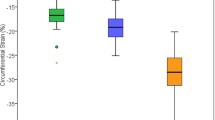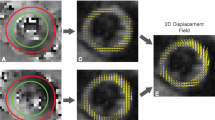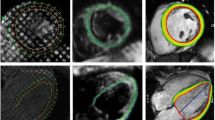Abstract
Fast cine displacement encoding with stimulated echoes (DENSE) has comparative advantages over tagged MRI (TMRI) including higher spatial resolution and faster post-processing. This study computed regional radial and circumferential myocardial strains with DENSE displacements and validated it in reference to TMRI, according to American Heart Association (AHA) guidelines for standardized segmentation of regions in the left ventricle (LV). This study was therefore novel in examining agreement between the modalities in 16 AHA recommended LV segments. DENSE displacements were obtained with spatiotemporal phase unwrapping and TMRI displacements obtained with a conventional tag-finding algorithm. A validation study with a rotating phantom established similar shear strain between modalities prior to in vivo studies. A novel meshfree nearest node finite element method (NNFEM) was used for rapid computation of Lagrange strain in both phantom and in vivo studies in both modalities. Also novel was conducting in vivo repeatability studies for observing recurring strain patterns in DENSE and increase confidence in it. Comprehensive regional strain agreements via Bland–Altman analysis between the modalities were obtained. Results from the phantom study showed similar radial-circumferential shear strains from the two modalities. Mean differences in regional in vivo circumferential strains were −0.01 ± 0.09 (95% limits of agreement) from comparing the modalities and −0.01 ± 0.07 from repeatability studies. Differences and means from comparison and repeatability studies were uncorrelated (p > 0.05) indicating no increases in differences with increased strain magnitudes. Bland–Altman analysis and similarities in regional strain distribution within the myocardium showed good agreements between DENSE and TMRI and show their interchangeability. NNFEM was also established as a common framework for computing strain in both modalities.






Similar content being viewed by others
References
Agarwal, H. K., K. Z. Abd-Elmoniem, and J. L. Prince. Total removal of unwanted harmonic peaks (TruHARP) MRI for single breath-hold high-resolution myocardial motion and strain quantification. Magn. Reson. Med. 64(2):574–585, 2010.
Aletras, A. H., S. Ding, R. S. Balaban, and H. Wen. DENSE: displacement encoding with stimulated echoes in cardiac functional MRI. J. Magn. Reson. 137:247–252, 1999.
Altar, E., and E. R. McVeigh. Optimization of tag thickness for measuring position with magnetic resonance imaging. IEEE Trans. Med. Imaging 13(1):152–160, 1994.
Atkinson, K. A. An Introduction to Numerical Analysis. New York: John Wiley and Sons, p. 108 pp, 1988.
Axel, L., and L. Dougherty. MR imaging of motion with spatial modulation of magnetization. Radiology 171:841–845, 1989.
Babushka, I., U. Banerjee, and J. Osborn. Meshless and generalized finite element methods: a survey of major results. In: Meshfree Methods for Partial Differential Equations, edited by M. Griebel, and M. A. Schweitzer. Berlin: Springer, 2002.
Babushka, I., and B. Q. Guo. The h, p and h-p version of the finite element method; basis theory and applications. Adv. Eng. Softw. 15(3–4):159–174, 1992.
Bayly, P. V., P. G. Massouros, E. Christoforou, A. Sabet, and G. M. Genin. Magnetic resonance measurement of transient shear wave propagation in a viscoelastic gel cylinder. J. Mech. Phys. Solids 56(5):2036–2049, 2008.
Bergvall, E., P. Cain, H. Arheden, and G. Sparr. A fast and highly automated approach to myocardial motion analysis using phase contrast magnetic resonance imaging. J. Magn. Res. Imaging 23:652–661, 2006.
Bland, J. M., and D. G. Altman. Statistical methods for assessing agreement between two methods of clinical measurement. Lancet 8476:307–310, 1986.
Cerqueira, M. D., N. J. Weissman, V. Dilsizian, A. K. Jacobs, S. Kaul, W. K. Laskey, D. J. Pennell, J. A. Rumberger, T. Ryan, and M. S. Verani. Standardized myocardial segmentation and nomenclature for tomographic imaging of the heart: a statement for healthcare professionals from the Cardiac Imaging Committee of the Council on Clinical Cardiology of the American Heart Association. Circulation 105:539–542, 2002.
Constable, R. T., K. M. Rath, A. J. Sinusas, and J. C. Gore. Development and evaluation of tracking algorithms for cardiac wall motion analysis using phase velocity MR imaging. Magn. Reson. Med. 32:33–42, 1994.
Cupps, B. P., A. K. Taggar, L. M. Reynolds, J. S. Lawton, and M. K. Pasque. Regional myocardial contractile function: multiparametric strain mapping. Interact. Cardiovasc. Thorac. Surg. 10:953–957, 2010.
Dougherty, L., J. C. Asmuth, A. S. Blom, L. Axel, and R. Kumar. Validation of an optical flow method for tag displacement estimation. IEEE Trans. Med. Imaging 18(4):359–363, 1999.
Edvardsen, T., B. L. Gerber, J. Garot, D. A. Bluemke, J. A. Lima, and O. A. Smiseth. Quantitative assessment of intrinsic regional myocardial deformation by Doppler strain rate echocardiography in humans: validation against 3-dimensional tagged magnetic resonance imaging. Circulation 106:50–56, 2002.
Garot, J., D. A. Bluemke, N. F. Osman, C. E. Rochitte, E. R. McVeigh, E. A. Zerhouni, J. L. Prince, and J. A. C. Lima. Fast determination of regional myocardial strain fields from tagged cardiac images using harmonic phase MRI. Circulation 101:981–988, 2000.
Ghiglia, D. C., and M. D. Pritt. Two-Dimensional Phase Unwrapping: Theory, Algorithms, and Software. New York: Wiley, p. 56 pp, 1998.
Hexeberg, E., D. C. Homans, and R. J. Bache. Interpretation of systolic wall thickening: can thickening of a discrete layer reflect fibre performance? Cardiovasc. Res. 29:16–21, 1995.
Itoh, K. Analysis of the phase unwrapping problem. Appl. Opt. 21(14):2470, 1980.
Jenkinson, M. Fast, automated N-dimensional phase-unwrapping algorithm. Magn. Reson. Med. 48:193–197, 2003.
Kim, D., W. D. Gilson, C. M. Kramer, and F. H. Epstein. Myocardial tissue tracking with 2D cine displacement-encoded MRI—development and initial evaluation. Radiology 230:862–871, 2004.
Knutsen, A. K., N. Ma, A. K. Taggar, B. D. Brady, B. P. Cupps, and M. K. Pasque. Heterogeneous distribution of left ventricular contractile injury in chronic aortic insufficiency. Ann. Thorac. Surg. 93:1121–1127, 2012.
Korosoglou, S., P. M. Humpert. Futterer, N. Riedle, D. Lossnitzer, B. Hoerig, H. Steen, E. Giannitsis, N. F. Osman, and H. A. Katus. Strain-encoded cardiac MR during high-dose dobutamine stress testing: comparison to cine imaging and to myocardial tagging. J. Magn. Res. Imaging 29:1053–1061, 2009.
Kreyszig, E. Advanced Engineering Mathematics. New York: Wiley, p. 333 pp, 1997.
Lauterbur, P. C. Image formation by induced local interactions: examples of employing nuclear magnetic resonance. Nature 242(5394):190–191, 1973.
Liu, G. R. Meshfree Methods: Moving Beyond the Finite Element Method. Boca Raton: CRC Press, 2009.
Lotz, J., C. Meier, A. Leppert, and M. Galanski. Cardiovascular flow measurement with phase-contrast MR imaging: basic facts and implementation. Radiographics 22:651–671, 2002.
Lutz, A., A. Bornstedt, R. Manzke, P. Etyngier, G. U. Nienhaus, W. Rottbauer, and V. Rasche. Volumetric motion quantification by 3D tissue phase mapped CMR. J. Cardiovasc. Magn. Reson. 14:74, 2012.
Lutz, A., J. Paul, A. Bornstedt, G. U. Nienhaus, P. Etyngier, P. Bernhardt, W. Rottbauer, and V. Rosche. Combination of tagging and tissue phase mapping to accelerate myocardial motion measurements in three directions. Magn. Reson. Mater. Phys. 26:239–247, 2013.
McVeigh, E. R., and E. A. Zerhouni. Noninvasive measurement of transmural gradients in myocardial strain with MR imaging. Radiology 180:677–683, 1991.
Meyer, F. G., R. T. Constable, A. J. Sinusas, and J. S. Duncan. Tracking myocardial deformation using phase contrast MR velocity fields: a stochastic approach. IEEE Trans. Med. Imaging 15(4):453–465, 1996.
Moore, C. C., S. B. Reeder, and E. R. McVeigh. Tagged MR imaging in a deformable phantom: photographic validation. Radiology 190:765–769, 1994.
Moulton, M. J., L. L. Creswell, S. W. Downing, R. L. Actis, B. A. Szabo, M. W. Vannier, and M. K. Pasque. Spline surface interpolation for calculating 3-D ventricular strains from MRI tissue tagging. Am. J. Physiol. 270:H281–H297, 1996.
Moustakidis, P., B. P. Cupps, B. J. Pomerantz, R. P. Scheri, H. S. Maniar, A. M. Kates, R. J. Gropler, M. K. Pasque, and T. M. Sundt. Noninvasive, quantitative assessment of left ventricular function in ischemic cardiomyopathy. J. Surg. Res. 116:187–196, 2004.
Osman, N. F., W. S. Kerwin, E. R. McVeigh, and J. L. Prince. Cardiac motion tracking using CINE harmonic phase (HARP) magnetic resonance imaging. Magn. Reson. Med. 42:1048–1060, 1999.
Osman, N. F., S. Sampath, E. Atalar, and J. L. Prince. Imaging longitudinal cardiac strain on short-axis images using strain-encoded MRI. Magn. Reson. Med. 46:324–334, 2001.
Sampath, S., J. A. Debryshire, E. Atalar, N. F. Osman, and J. L. Prince. Real-time imaging of two-dimensional cardiac strain using a harmonic phase magnetic resonance imaging (HARP-MRI) pulse sequence. Magn. Reson. Med. 50:154–163, 2003.
Shimizu, Y., A. Amano, and T. Matsuda. Oblique 3D MRI tags for the estimation of true 3D cardiac motion parameters. Int. J. Cardiovasc. Imaging 26(8):905–921, 2010.
Spottiswoode, B. S., X. Zhong, A. T. Hess, C. M. Kramer, E. M. Meintjes, B. M. Mayosi, and F. H. Epstein. Tracking myocardial motion from cine DENSE images using spatiotemporal phase unwrapping and temporal fitting. IEEE Trans. Med. Imaging 26(1):15–30, 2007.
Spottiswoode, B. S., X. Zhong, C. H. Lorenz, B. Mayosi, E. M. Meintjes, and F. H. Epstein. Motion guided segmentation for cine DENSE MRI. Med. Image Anal. 3(1):105–115, 2009.
Szabo, B. A., and I. Babuska. Finite Element Analysis. New York: Wiley, pp. 57–69, 1991.
Young, A. A., D. L. Kraitchman, L. Dougherty, and L. Axel. Tracking and finite element analysis of stripe deformation in magnetic resonance tagging. IEEE Trans. Med. Imaging 14(3):413–421, 1995.
Young, A. A., B. Li, R. S. Kirton, and B. R. Cowan. Generalized spatiotemporal myocardial strain analysis for DENSE and SPAMM imaging. Magn. Reson. Med. 67:1590–1599, 2012.
Zerhouni, E. A., D. M. Parish, W. J. Rogers, A. Yang, and E. P. Shapiro. Human heart: tagging with MR imaging—a method for noninvasive assessment of myocardial motion. Radiology 169:59–63, 1988.
Zhong, X., L. B. Gibberman, B. S. Spottiswoode, A. D. Gilliam, C. H. Meyer, B. A. French, and F. H. Epstein. Comprehensive cardiovascular magnetic resonance of myocardial mechanics in mice using three-dimensional cine DENSE. J. Cardiovasc. Magn. Reson. 13:83–92, 2011.
Zhong, X., B. S. Spottiswoode, C. H. Meyer, M. K. Kramer, and F. H. Epstein. Imaging three-dimensional myocardial mechanics using navigator-gated volumetric spiral cine DENSE MRI. Magn. Reson. Med. 64:1089–1097, 2010.
Zienkiewicz, O. C., R. L. Taylor, and J. Z. Zhu. The Finite Element Method: Its Basis and Fundamentals. Oxford: Butterworth-Heinemann, p. 54 pp, 2000.
Zwanenburg, J. J., J. P. Kuijer, J. T. Marcus, and R. M. Heethaar. Steady-state free precession with myocardial tagging: CSPAMM in a single breathhold. Magn. Reson. Med. 49(4):722–730, 2003.
Acknowledgments
We are thankful to Ms. Lina Reynolds and Ms. Beckah Brady for their active role in recruiting healthy subjects for our study. We also thank Siemens (Dr. Xiaodong Zhong) for the imaging software for DENSE. This study was partly funded by NIH Grant R01 HL112804.
Author information
Authors and Affiliations
Corresponding author
Additional information
Associate Editor Jane Grande-Allen oversaw the review of this article.
Appendix A
Appendix A
Radial-circumferential shear strain (ε rθ ) calculated using two different FEA techniques which were (left) nearest neighbor finite element method (NNFEM) and (right) Measurement Analysis (MEA). MEA involved division into six unequal tetrahedron elements in the same way a single 2D myocardial slice is segmented.

Rights and permissions
About this article
Cite this article
Kar, J., Knutsen, A.K., Cupps, B.P. et al. A Validation of Two-Dimensional In Vivo Regional Strain Computed from Displacement Encoding with Stimulated Echoes (DENSE), in Reference to Tagged Magnetic Resonance Imaging and Studies in Repeatability. Ann Biomed Eng 42, 541–554 (2014). https://doi.org/10.1007/s10439-013-0931-2
Received:
Accepted:
Published:
Issue Date:
DOI: https://doi.org/10.1007/s10439-013-0931-2




